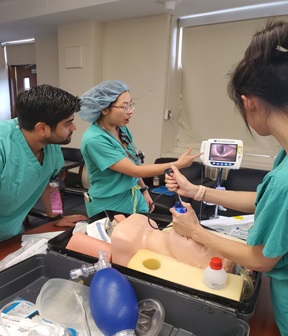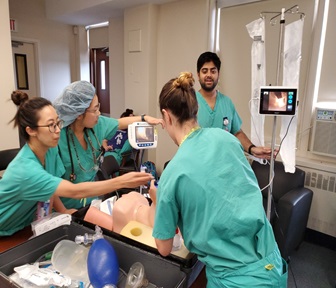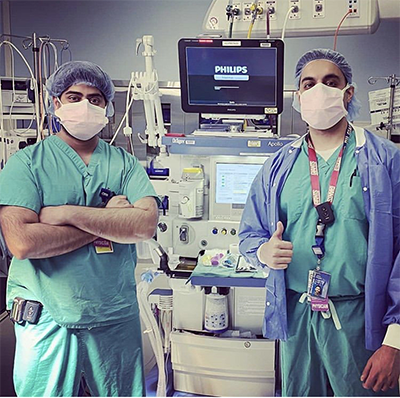Clinical Curriculum
Fundamental Clinical Skills of Medicine (formerly Clinical Base) Year
The Fundamental Clinical Skills of Medicine (PGY-1) residents spend the year at WMC.
In addition to providing foundational exposure to Clinical Anesthesiology, Pain Management, Emergency Medicine, POCUS, Patient Safety/Quality Improvement, Specialty Consultation Services and Critical Care, interns learn inpatient care on Internal Medicine wards, including six weeks of night float (shift duration capped at 12 hours).
Clinical Anesthesia-1 (CA-1 Year)
During the first rotation block, the CA-1s refresh the basic skills acquired during the PGY-1 year with the guidance of two faculty preceptors, a primary and a substitute. They are in the OR every day, exempt from overnight call, and attend daily introductory lectures.
The next six blocks of clinical anesthesia (CA-1) teach new residents the basics of uncomplicated anesthetic management while encouraging self-guided reading and study. A dedicated CA-1 monthly didactic afternoon follows a Basic Examination of the ABA curriculum. A variety of web-based learning and assessment resources are available, including Access Anesthesiology, the extensive online catalog of the NYMC Library, and a subscription to Anesthesia ToolBox, and TrueLearn a Qbank. Residents also have access to the HeartWorks and BodyWorks ultrasound simulator.
Call begins at 12 p.m. on weekdays for CA-1s and CA-2s and is OR-based. CA-3s start call at 4:30 p.m. An average of four calls a month should be expected. Saturday and Sunday call begins at 7 a.m. and lasts 24 hours.
During the second half of the CA-1 year, residents begin subspecialty rotations, so that they have had exposure to all the subspecialties before the fellowship application season begins during the fall of the CA-2 year.
Therefore, starting with Block 7, 18 months of clinical anesthesia training (CA-1, CA-2) are divided into a series of mandatory specialty rotations that cover a range of clinical challenges in the intensive care unit, the specialty operating rooms, NON-OR anesthesia sites and the obstetrical suite. Residents also grow proficiency in regional anesthesia, Point of Care Ultrasound, and comprehensive pain management for pediatric and adult patients in a broad range of settings. In addition, they are assigned rotations in the anesthetic preoperative assessment clinic and in the post-anesthesia care unit.
CA-2 call residents cover high-risk OB, complex OR cases and airway management in the Trauma bays and elsewhere outside of the OR. Call frequency is approximately 4 per rotation block and the call hours are the same as in the CA-1 year.
A staff anesthesiologist is assigned as supervisor to each anesthetic administered by a resident. Difficult cases mandate one-on-one supervision, and supervision ratio at WMC is often one-on-one, especially for CA-1 residents at the beginning of training and in the first of two required subspecialty rotations. Two attending anesthesiologists are always in-house 24 hours a day, seven days a week at the WMC and Danbury hospitals to provide direct supervision. Back-up general call and subspecialty call Attendings in Cardiac, Pediatric and Transplant Anesthesia are scheduled 24/7 as well.
At the end of the CA-1 year, the residents are able to fully participate in the clinical and academic missions of the department and assume a major role in the care of more seriously ill patients or those requiring more complicated anesthetic management, and they no longer require continuous one-on-one supervision for subspecialty cases.
Clinical Anesthesia-2 (CA-2 Year)
In the second Clinical Anesthesia year (CA-2), emphasis is placed on the second round of subspecialty rotations; the resident has almost full responsibility for the conduct of anesthesia under indirect supervision. The residents’ experience includes major cardiovascular, thoracic, and neurosurgical anesthesia, diagnostic and therapeutic nerve blocks, transplantation anesthesia, geriatric anesthesia, intensive and respiratory care of surgical and medical patients, radical cancer surgery, obstetrical anesthesia, pediatric anesthesia, and anesthesia for emergency surgery, as well as outpatient surgery and non-OR anesthesia. By the end of the CA-2 year, it is expected that the resident can safely anesthetize most patients.
At WMC, residents complete all the required rotations and the minimum number of index cases required for graduation by the end of CA-2 year and often earlier.
Specialized Year (CA-3 Year)
All CA-3 residents complete six blocks of the Advanced Clinical Track rotation in which they are assigned to the more difficult or complex anesthetic procedures or to the most seriously ill patients. The remaining seven blocks of the CA-3 year is made up of sub-specialty and advanced elective rotations, including:
- Rotations in any of the subspecialties
- POCUS
- Complex Airway Management
- Obstetric Anesthesia at Mount Sinai West Hospital
- Research
CA-3 residents take call as Team Captains; this role teaches them how to manage the emergency OR assignments in a busy trauma/referral center and how to supervise junior residents and CRNAs. Team Captain call starts at 4:30 p.m. on weekdays.
Motivated residents will have acquired enough cases and experience with POCUS and/or TEE to qualify for the Special Competence in Basic Perioperative Transesophageal Echocardiography (Basic PTEeXAM®) and/or POCUS certification.
At the completion of the CA-3 year, the graduating resident is expected to be competent in all areas of anesthesia and be ready for independent practice, as evidenced by achievement of prescribed milestones in the ACGME Core Competencies of Patient Care, Medical Knowledge, Interpersonal Communication Skills, Professionalism, Practice-Based Improvement and Systems-Based practice.
Leave Policies
The ABA restricts the total amount of time a Clinical Anesthesia resident may be absent from training to 60 days. Absence due to longer illness or parental leave without training extension may be allowed in special circumstances if the resident is in good standing, and requires both Program and ABA approval. Conference time to present scholarly work is not included in the 60-day limit.
Our residents are required to take 20 working days of vacation time per academic year, at minimum in one-week intervals.
Training in Westchester County
Westchester Medical Center is located in Valhalla, in southern Westchester County, NY, within commuting distance to New York City.
Westchester citizens enjoy a vibrant night-life, celebrations of history and heritage, water activities, outdoor recreation, fine dining, and numerous family-friendly activities.
Often called "the city that never sleeps," New York City offers a variety of activities such as a picnic in Central Park, cityscapes on the "Top of the Rock" at Rockefeller Center, Broadway shows, the Bronx Zoo, professional sports (the Yankees, the Mets, the Knicks, the Rangers, the Giants and the Jets), concerts and some of the best and most ethnically diverse restaurants in the world.
Quick access to New York City is only one of the benefits to living in Westchester County. White Plains, the commercial and cultural hub of Westchester County offers public transportation, an active nightlife, fine dining, performance arts, excellent living accommodations, and great shopping.
For those seeking an active lifestyle, the Hudson Valley offers plenty of outdoor activities and stunning views of the Hudson River.
Although there are many more beautiful parks and recreation areas nearby, let us highlight three:
- Bear Mountain State Park, 40-minute drive north of WMC, is located on the west bank of the Hudson River and offers hiking, biking and cross-country ski trails along the Appalachian Trial, shaded picnic and camping areas, and opportunities for lake and river fishing.
- Rockefeller State Park is a 1,233-acre park with 20 miles of trails through open meadows, dense forests, meandering rivers, and wetlands. Activities include horseback riding, trail running, nature walks, bird watching, and sport fishing. Stone Barns Center for Food & Agriculture, located within walking distance of Rockefeller state park, is an 80-acre farm and educational center that promotes sustainable agriculture, local food, and community-supported farms.
- Harriman State Park, 30 miles away from WMC, is the second-largest park in NY and boasts 32 lakes and reservoirs, 200 miles of hiking trails, three beaches, camping areas and scenic views.
There are also many beaches lining the Hudson River, the Long Island Sound, and the Atlantic Ocean, all within easy driving distance from WMC.
For those with an interest in local history, Westchester County was the preferred location for the many historic mansions built by some of the most famous American families; they are open for the public to enjoy. Let us list:
- The Kykuit mansion, former home of the rich and powerful Rockefeller family.
- The Sunnyside Mansion, home to the American author Washington Irving, of the “Rip Van Winkle” (1819) and “The Legend of Sleepy Hollow” (1820) fame, was built in 1835.
- In 1880 Lyndhurst mansion became a 67-acre seasonal residence of railroad magnate and one of the Robber Barons of the Gilded Age, Jay Gould.
The Hudson Valley also offers numerous historic and cultural festivals throughout the year, including the "Horseman's Hollow" in Sleepy Hollow and the "Clearwater's Great Hudson River Revival" Music Festival in Croton-on-Hudson.
Westchester’s public schools are excellent and there are many employment opportunities for your significant others. The county has everything you'll need for creating a wonderful living experience.
Westchester Magazine
Hudson Valley
Didactic Curriculum
Fundamental Clinical Skills of Medicine (formerly Clinical Base) Year
PGY-1 residents have rotation-specific didactic sessions within the Department of Medicine as well as the Department of Anesthesiology.
Clinical Anesthesia-1 (CA-1 Year)

Throughout the month of July, CA-1 residents receive a core introductory daily lecture series five days a week. These sessions include basic science topics and case reviews.
All Clinical Anesthesia Residents and available PGY-1s
Every Wednesday morning the Departmental Grand Rounds program features intra- and extramural guest speakers, as well as Morbidity and Mortality discussions.
Residents attend didactics divided by class on a rotating basis every Thursday from 3 p.m. - 5 p.m. Sessions may include traditional lectures, small-group simulation sessions, or workshops. Every fourth Thursday, members of all classes attend educational activities from 2:00p.m. to 5:00p.m. that are appropriate for all levels of training such as Journal Club, “Anesthesia Jeopardy”, keyword review, and POCUS cases. During this time residents also have the opportunity to meet with the Chief Residents without faculty attendance so that concerns can be voiced freely. The Program strictly protects educational time and residents are free of all clinical responsibilities during scheduled activities.
Once a month, on Wednesday afternoon, all the residents attend the departmental Quality Improvement meeting.
Tests/Exams
All residents MUST pass USMLE Step 3 before starting the CA-1 year. Advancement in the program is contingent upon the resident's professional performance, attendance at conferences, attainment of appropriate milestones, staff evaluations of clinical care - passing the BASIC Examination of the American Board of Anesthesiology at the end of the CA-1 year. Resident advancement and standing is also influenced by satisfactory performance on the Anesthesia Knowledge Tests (AKT 0, 1, 6 and 24) and mandatory annual In-Training Examination (ITE) scores (the cut-off is set annually by the Clinical Competence Committee). The exams, along with timed monthly quizzes administered by the Program through TrueLearn allow each resident to assess their own performance as well as against the peer group nationally. The data allow the Program Director to re-orient didactic and clinical teaching toward areas of individual or Program deficiencies.
Simulation and Workshops

Every year, starting at the PGY-1 level, residents participate in simulation sessions administered at a state-of-the-art facility at NYMC. Monthly sessions focus on rare anesthetic emergencies and team work. A major focus of simulation is preparation for the OSCEs of the Applied Examination of the ABA; in the simulation center, residents interact with standardized patients, and are provided a debrief and an analysis of video recordings.
Beginning in the PGY-1 year, residents participate in a comprehensive POCUS program that includes simulation and bedside teaching. POCUS is increasingly utilized in both the ICUs and PACU, and is available as a popular elective rotation for CA-3s.
A whole-body ultrasound (POCUS, TTE, TEE) simulation lab is conveniently located just outside the WMC ORs and is available for scheduled and impromptu hands-on sessions led by experienced faculty.
International Experience
Residents can accompany faculty to low-income countries to not only teach local anesthesia providers but also engage in direct anesthetic care. Pre-pandemic destinations included Kenya and Honduras. Residents with a special interest in international anesthesiology (Global Medicine) can apply for funding for a month-long experience that may be eligible for ABA credit.

Scholarly Activity
Each resident, with mentoring by faculty members, is required to participate in scholarly activities, which, at minimum, include medically challenging cases, Quality Improvement project presentations at national conferences, M&M presentations at departmental meetings and completion of a practice-based learning and improvement project. Some residents will participate in or even initiate clinical research projects, leading to publication during training. The didactic curriculum emphasizes evidence-based medicine and graduates are expected to be committed to lifelong learning.
The graduating Class of 2023 cumulatively had 17 presentations at national meetings and eight PubMed Indexed publications achieved during their training, with several more in press at the time of graduation.